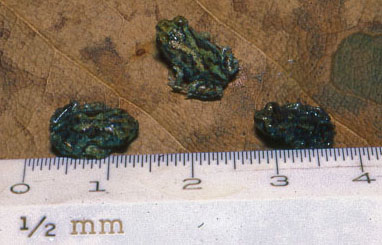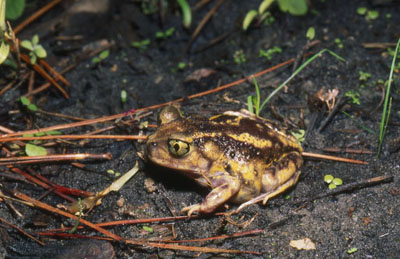Four hurricanes visited Florida in 2004: Charley, Frances, Ivan and Jeanne. Charley crossed the southern peninsula from southwest to northeast. Frances crossed the central peninsula from southeast to northwest, then moved up the Gulf coast and headed into the middle panhandle. Ivan hit the western panhandle. Jeanne sat off the east coast for several days and then moved west across the peninsula and north into Georgia. Hurricane winds and/or rains impacted virtually every part of Florida. National news media showered the public with images of communities reduced to matchstick rubble; buildings with no roofs or missing walls; downed trees and power lines; flooded roads and houses; boats smashed in their moorings; and crops blown away.
However, the hurricanes also produced one of the most spectacular frog and toad breeding seasons that Florida has seen in decades, and the success of this reproductive event is in sharp contrast with many other anuran populations.

Photo by Kenny Krysko
Of the 5,067 species of frogs and toads scattered round the world, 32 species have become extinct and 1,653 species, an estimated 33 percent of the total, are threatened. By comparison only 12 percent of all birds and 23 percent of all mammals are threatened.
Most of the declines in amphibian populations have occurred as a result of habitat loss, frequently brought on by human activities such as urban sprawl, expansion of agricultural acreage, highway construction, drainage and pollution of waterways. But while many amphibian populations are disappearing, in 2004 the Florida populations were offered a reprieve.
For example, Summer Creek, an intermittent stream in northwest Gainesville, is dry most of the year. Rains soak into the ground rather than flow down the creek bed. But when sufficient rain falls to saturate the soil, Summer Creek pours into a low area with no outlet, where it forms a temporary pond that slowly seeps into the ground and recharges the Floridan aquifer.
On Sept. 5-7, 2004, the rains from Hurricane Frances turned Summer Creek into a raging torrent that filled the recharge area producing a 12-acre, 25-foot-deep pond. The low barometric pressure that accompanied the tropical deluge whipped the local frogs and toads into a breeding frenzy. As soon as the winds subsided the nights were filled with choruses of male squirrel tree frogs, green tree frogs, and eastern spadefoot toads, calling the females to the newly filled pond.
Eastern spadefoot toads, Scaphiopus holbrooki holbrooki, as their name implies, have a horny spade on the hind foot that is used to dig borrows in the floor of hardwood hammocks where they live. They emerge about once a week to feed on the surface.

Photo by F. Wayne King
However, torrential rain accompanied by low barometric pressure brings the male spadefoots to the nearest temporary pond where they sing, ‘waank, waank, waank,’ to attract females. By the second day the submerged grass in the edge of the pond at the end of Summer Creek was covered with ropes of fertilized eggs, each containing 2,000 to 2,500 eggs.
Within two days the eggs were hatched and clouds of tiny bronze tadpoles were swarming around the pond feeding. Temporary ponds are ideal for spadefoots because they contain no egg- or tadpole-eating fish. However, any anuran that breeds in a temporary pond is in a race to get its eggs hatched, its tadpoles grown and metamorphosed into baby frogs or toads before the pond goes dry. Spadefoot toads are among the fastest in this developmental race and in the three weeks after the eggs were laid, they hatched into tadpoles and transformed into tiny threeeighths- inch-long spadefoot toads.
Hurricane Jeanne arrived on Sept. 26-27, 2004, and its rains again filled the shrinking pond, which flushed the emerging millions of baby spadefoots out of the grass around the edge of the water. An unrelenting series of tiny half-inch hops marched the baby spadefoots away from the natal pond to find homes in the surrounding forest.

Photo by Kenny Krysko
The migrating horde did not stop to feed or to avoid predators. It spread out like a carpet unrolling across the habitat, falling into depressions and piling up against obstructions. Within four days the carpet of toadlets had dispersed 1,200 feet from the pond and was still moving. Similar breeding aggregations and dispersal of baby toads were reported in the press throughout Alachua County in northcentral Florida, in Sarasota in southwest Florida, and in Palm Beach and Martin counties in southeast Florida. Tree frogs do not metamorphose as rapidly as spadefoot toads, but six to eight weeks after Hurricane Frances, hundreds of three-fourths-inch-long baby squirrel tree frogs and green tree frogs started emerging from the drying temporary ponds and showing up at night on lighted patio windows to feed on insects drawn to the lights.
Metamorphic aggregations of baby frogs and toads have been reported in Florida in the past, but never have they been so widespread throughout the state. (See W.T. Neill. 1957. Notes on metamorphic and breeding aggregations of the eastern spadefoot, Scaphiopus holbrooki (Harlan). Herpetologica, 13(3):185-187; and F. Wayne King and Steve A. Johnson. 2002. A Plague of Frogs or a Jubilee of Toads. 8 p. [Online] Available at: www.floridamuseum.ufl.edu/herpetology/links/plague-frogs-or-jubilee-toads/
This year hurricanes wreaked havoc on man’s endeavors in Florida, but in sharp contrast to the many declining amphibian populations in other parts of the world, hurricanes were a blessing that provided an ideal environmental stimulus for many of the state’s frog and toad populations to breed and increase their numbers. Thank goodness for hurricanes.
F. Wayne King is Curator of Herpetology at the Florida Museum of Natural History. He served as director of the Florida Museum from 1979 to 1985. His research focuses primarily on the ecology and conservation of crocodilians and the impact of international trade on their populations. He also has spent more than 40 years documenting the introduction and spread of exotic reptile and amphibian species in Florida.
Learn more about the Herpetology Collection at the Florida Museum.